
I don’t know about you, but I have tomatoes everywhere right now. My vegetable baskets are filled with them, they are on the kitchen counters and more are ripening by the day (at least they would if the sun would ever come back out here).
This is a good situation to be in though because last year my tomato plants lagged on producing tomatoes so our pantry was getting a little low on pasta sauce and other tomato-based items. It should be fully stocked after this year though.
I grow primarily Roma tomatoes for canning, with a few cherry tomatoes and one slicing tomato plant.
Last winter, I wrote about a new experiment I was trying with my greenhouse and starting all of my tomatoes from seed. I was thinking about that blog just the other day and realized I hadn’t followed up on it yet.
When I first put the tomatoes out, I was a little concerned because I had transplanted them into the largest pots I had for them, but they were still getting very root bound. The temperatures just weren’t warm enough yet for me to be comfortable putting them outside. So instead, I gave them the best care I could in the greenhouse but the leaves were starting to wilt just a little.
Finally, it was time to plant them. I kept my fingers crossed that they would all bounce back. After a few weeks in the ground, they did just that. All of my plants except the one that something ate and I had to replace, really took off once their roots had room to spread out. They grew into nice sized plants and they are producing more tomatoes than I think I have ever had, while many people in the area are having smaller amounts of tomatoes this year.
I know that I will be starting my tomatoes from seed again next year – but maybe a couple of weeks later in the year. I want to see if I have the same results two years in a row. If so, I will always be starting my plants from seeds from now on.
With all of these tomatoes, it’s time to start preserving them. I’ll begin sharing recipes and things I have discovered in my upcoming blogs.
Until next time, happy garden-fresh eating!
Julie Clements is a Butler County Master Gardener.
Share your ideas for garden-fresh recipes or ways to preserve at julieclements75@gmail.com and some will be featured in upcoming columns.




 und like a lot, in fact it’s more than I have ever planted, but I am running low on all of my tomato-based canned foods, such as ketchup, salsa, canned tomatoes, tomato sauce, pasta sauce…Well you can see why I need so many plants. Let’s hope I can keep up with all of the canning when they start really producing.
und like a lot, in fact it’s more than I have ever planted, but I am running low on all of my tomato-based canned foods, such as ketchup, salsa, canned tomatoes, tomato sauce, pasta sauce…Well you can see why I need so many plants. Let’s hope I can keep up with all of the canning when they start really producing. st year and saw that I did plant tomatoes about this time. Yes, even I have trouble taking my own advice. The problem in Kansas is you never know what the weather is going to do. After planting on April 25 last year, we then had a frost about a week later. Every good gardener knows tomatoes and frost do not go together.
st year and saw that I did plant tomatoes about this time. Yes, even I have trouble taking my own advice. The problem in Kansas is you never know what the weather is going to do. After planting on April 25 last year, we then had a frost about a week later. Every good gardener knows tomatoes and frost do not go together. 



 Spring in Kansas can create a challenge for getting an early start on plants. Once the weather begins to warm up, the urge to start planting just can’t be denied. But unfortunately, just because there is a couple of weeks of warm weather, does not mean winter is over. The temperatures always drop below freezing at least one or two more times. Even in the green house, that is too cold for tender seedlings to survive.
Spring in Kansas can create a challenge for getting an early start on plants. Once the weather begins to warm up, the urge to start planting just can’t be denied. But unfortunately, just because there is a couple of weeks of warm weather, does not mean winter is over. The temperatures always drop below freezing at least one or two more times. Even in the green house, that is too cold for tender seedlings to survive.
 It’s almost time for that first planting of the season. I know I’m excited to get out and dig in my garden.
It’s almost time for that first planting of the season. I know I’m excited to get out and dig in my garden.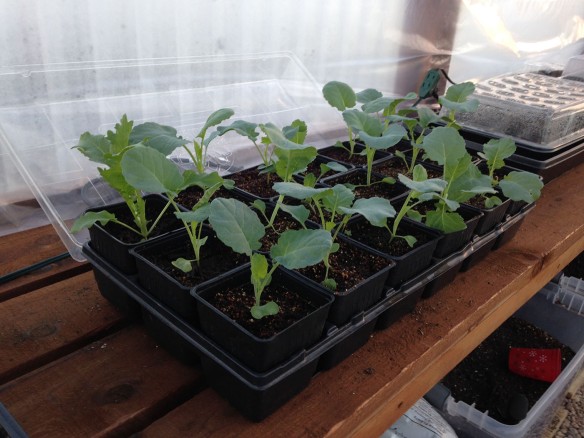
 seed.Usually I just buy the small plants during some of the early sales in the season.
seed.Usually I just buy the small plants during some of the early sales in the season. On a side note, I’m hopeful to have some fresh salads soon from the lettuce that I started in my greenhouse. With the help of a little heat at night to keep the temps up, it is flourishing. If you don’t have a greenhouse, you could start a small pot of lettuce on your windowsill in a south-facing window. The seeds sprout in no time, then once the leaves are large enough to eat, start harvesting what you need for each meal and it will keep growing back.
On a side note, I’m hopeful to have some fresh salads soon from the lettuce that I started in my greenhouse. With the help of a little heat at night to keep the temps up, it is flourishing. If you don’t have a greenhouse, you could start a small pot of lettuce on your windowsill in a south-facing window. The seeds sprout in no time, then once the leaves are large enough to eat, start harvesting what you need for each meal and it will keep growing back.
